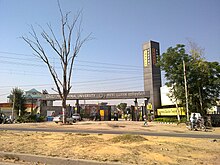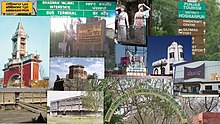
Back দোয়াব (পাঞ্জাব) Bengali/Bangla ജലന്ധർ ദൊവാബ് Malayalam Doaba NB ਦੋਆਬਾ Punjabi Doaba SIMPLE பிஸ்த் தோவாப் Tamil دوآبہ Urdu

| Part of a series on |
| Punjabis |
|---|
 |
 Punjab portal |










Doaba, also known as Bist Doab or the Jalandhar Doab,[1] is the region of Punjab, India that lies between the Beas River and the Sutlej River.[2] People of this region are given the demonym "Doabia". The dialect of Punjabi spoken in Doaba is called "Doabi". The term "Doaba" or "Doab" is derived from Persian دو آب (do āb "two water") meaning "land of two rivers".[3] The river Sutlej separates Doaba from the Malwa region to its south and the river Beas separates Doaba from the Majha region to its north.
Scheduled castes form more than 40% of the population in Doaba. This area is also called the NRI Hub of Punjab as a consequence of the migration of a significant percentage of Doabias.[4]
- ^ Singh, Harbans. The Encyclopedia of Sikhism. Vol. 4: S-Z. Punjabi University, Patiala. p. 397.
- ^ Grover, Parminder Singh; Singh, Davinderjit (2011). "Section 1: Introduction – Regions of Punjab". Discover Punjab: Attractions of Punjab. Photographs by Bhupinder Singh. Ludhiana, Punjab, India: Golden Point Pvt Lmt.
Regions of Punjab: The much-truncated India's portion of present Punjab is divided into three natural regions: The Maiha, The Doaba, The Malwa. Majha: Majha starts northward from the right bank of river Beas and stretches up to the Wagha village, which marks the boundary between India and Pakistan. Majha in Punjabi means the heartland. The region is divided into three districts: 1. Amritsar, 2. Gurdaspur, 3. Tarn Taran. Doaba: The rivers Sutlei in the south and Beas in the North bound the Doaba of Puniab. The Doaba region is divided into four districts: 1. Jalandhar, 2. Nawanshahr, 3. Kapurthala, 4. Hoshiarpur. Malwa: The area south of the river Sutlej is called Malwa. The name has stuck because a clan called Molois (sometimes written as Malawis in ancient works) once ruled this area, which must have spread up to present State of Gujrat which was known as the Subah of Malwa as late as the Mughul times. Malwa the largest part of the Punjab is divided into the following 12 districts after the names of their headquarters: 1. Bathinda, 2. Barnala, 3. Faridkot, 4. Fatehgarh Sahib, 5. Ferozepur, 6. Ludhiana, 7. Mansa, 8. Moga, 9. Sangrur, 10. Muktsar, 11. Patiala, 12. Rup Nagar, 13. SAS Nagar - Mohali.
- ^ "GAZETTEER OF INDIA". Archived from the original on 4 March 2016. Retrieved 3 April 2014.
- ^ Gurharpal Singh; Darsham Singh Tatla (2006). Sikhs in Britain: The Making of a Community. London: Zed Books Ltd. p. 40. ISBN 978-1-84277-717-6.
big villages doaba.